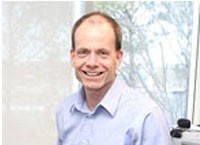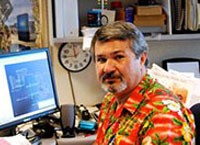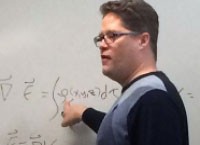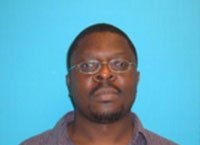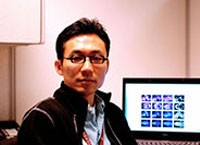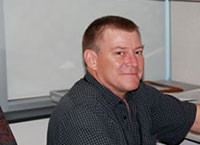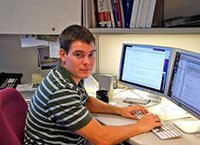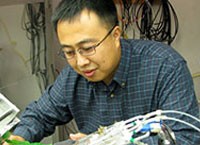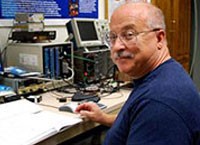| Tel:(757) 269-7090 Email:drew@jlab.org |
Drew has led the group since 2008 and has over 20 years of experience in the operation, design and construction of scintillator and solid state-based radiation detectors for both non-imaging and imaging applications. He has used his radiation physics expertise for radioisotope detection in clinical, pre-clinical and, more recently, in plant biology research. In 2009, he was appointed the Laboratory Research Manager of the Radiochemistry and Instrumentation Scientific Focus Area for Jefferson Lab by the DOE Office of Biological and Environmental Research. He holds a joint appointment in The College of William Mary's department of Applied Science as an adjunct professor. Drew has authored or coauthored more than 100 articles on instrumentation development and applications that have been published as research papers, review articles, book chapters or conference records. He has several U.S. patents. He received a 2009 Excellence in Technology Transfer Award from the Federal Laboratory Consortium. Drew received his Ph.D. in Applied Science from The College of William and Mary in Virginia in 1998. In February 2015, Weisenberger assumed the additional role of Chief Technology Officer. In that role, he is responsible for advancing the development of technology from the lab's research programs and facilitating the transfer of technologies to industry.
| Tel:(757) 269-7022 Email:kross@jlab.org |
Brian is the mechanical engineer for the group. He leads the design and construction of detector mechanical systems for the group's nuclear physics research support and biological systems imaging projects. He has more than 37 years of experience in mechanical system design and construction for detector assemblies for nuclear physics experiments, medical imaging and commercial applications of nuclear imaging. Brian has designed and built gas systems to support various particle physics gas-based detectors. He has an A.S. in Applied Science from William Rainey Harper College in Palatine, Illinois. He has co-authored more than 90 research papers and has 11 patents. He received an R&D100 award in 1995 with Digiray Corporation and a 2009 Excellence in Technology Transfer Award. While working at Fermilab, Brian sailed with the Heart of America Syndicate, training for the 1987 America’s Cup on the 12-Meter Yacht Clipper. Brian currently trains the dogs of JLab staff members for therapy work.
| Tel:(757) 269-XXXX Email:christy@jlab.org |
Eric is a research scientist for the group. He has more than 10 years of experience in nuclear physics detector system design and construction. His recent research activities center on the use tracking drift chambers, scintillators and PMTs in nuclear physics research.
| Tel:(757) 269-XXXX Email:kagnanvo@jlab.org |
Kondo is a research scientist for the group. He has more than 10 years of experience in nuclear physics detector system design and construction. His recent research activities center on the design and construction of micro pattern gaseous detectors for nuclear physics research.
| Tel:(757) 269-5476 Email:sjlee@jlab.org |
Seungjoon is a research scientist for the group. His research activities focus on preclinical and clinical radionuclide medical imaging, as well as radioisotope imaging in plant biology. His expertise is in the application of nuclear physics detector instrumentation design and construction, computational image/signal processing and computational iterative image reconstruction applied to radioisotope imaging in biological systems. Seungjoon has more than seven years of experience with biomedical/nuclear imaging system development and computational algorithm design. His recent work includes instrumentation development and motion-corrected image software design for the multi-institutional collaboration to design and build an awake animal single-photon emission computed tomography (SPECT) / X-ray computed tomography (CT) system. He also conducted software development for the motion tracking system and for nuclear detector hardware integration. Prior to coming to Jefferson Lab, he was a Postdoctoral Research Associate in the Monolithic Systems Group at Oak Ridge National Laboratory. He has authored and co-authored more than 20 publications, and he holds a patent. He received his Ph.D. in Biomedical Engineering in 2006 from Texas A&M University in College Station, Texas.
| Tel:(757) 269-5849 Email:jem@jlab.org |
Jack is the electrical engineer for the group. He leads the design and testing of detector imaging electronics, detector systems and peripherals for the group's nuclear physics research support and biological systems imaging projects. He has extensive experience in electronics design and implementation for photomultiplier tubes, solid-state detectors and silicon photomultipliers. Jack has more than 25 years of experience in analog and digital electronics. Prior to joining the group, he was Assistant Professor of Engineering Physics and Director of the Laboratory for Advanced Instrumentation Research at Embry-Riddle Aeronautical University. He has co-authored more than 50 research papers and has designed and built electronics for detector systems for nuclear physics, space-based research and radiation detection. He is also active in educational community outreach activities. He received his M.S. degree in Electrical Engineering in 1983 from the University of Florida.
| Tel:(757) 269-7707 Email:mckisson@jlab.org |
John is the software engineer for the group. He has more than 14 years of experience in the development of control software for various computer platforms and data acquisition systems. John is an expert in the programming languages Microchip ASM, C, Objective C, C++, Java, PHP and MySQL. He develops the data acquisition and control software for the group’s various projects. Additionally, he has developed and implemented iterative image reconstruction software for nuclear medicine imaging applications. John also has hardware experience in the construction of electronics and mechanical components for detector systems. Prior to joining the group, he was a software developer for the Laboratory for Advanced Instrumentation Research at Embry Riddle Aeronautical University.
| Tel:(757) 269-5006 Email:wxi@jlab.org |
Wenze is a research scientist for the group. His research activities focus on preclinical and clinical radionuclide medical imaging, electro-optics, and nuclear physics instrumentation. His recent work has focused on the development of an externally modulated electro-optically coupled detector architecture for particle physics research that is radiation tolerant and immune to large magnetic fields. Additionally, he is developing a PET detector module based on silicon photomultiplier (SiPM) technology with a three-dimensional spatial resolution approaching 1 mm. He has more than seven years of experience in scintillator and solid-state-based radiation detector development for biomedical applications. Prior to joining the group, he was a Research Fellow in Medical Physics through the Science Application International Corporation/National Cancer Institute, National Institutes of Health. He has authored and co-authored more than 20 publications, and he holds a patent. In 2005, he was awarded the Maryland Technology Development TEDCO Award. His interests are in radiation detector development for nuclear physics research and biological systems research. He received his Ph.D. degree in Electrical Engineering in 2005 from the University of Maryland.
| Tel:(757) 269-7449 Email:zorn@jlab.org |
Carl is a research scientist for the group. He has more than 25 years of experience in nuclear physics detector system design and testing. His recent research activities center on the use of silicon photomultipiers (SiPMs) in particle physics and biomedical applications. One of Carl’s projects is to develop silicon photomultipliers with increased radiation tolerance and another is to adapt the SiPM technology for nuclear physics applications. Additionally, Carl is an expert in radiation damage effects on scintillators. Recently, using his optics background, Carl led the development of a Large Sample Spectrophotometer Facility for optical measurements (UV- VIS), with particular emphasis on handling large sample sizes such as lead glass. He is also exploring SiPM operation for bio-imaging applications where SiPM technology will be used to replace conventional vacuum photomultiplier technology. At present, this SiPM technology, originally developed for applications in nuclear physics, is being used in the development of a hand-held gamma camera for surgical applications. Carl has authored or coauthored more than 50 articles on nuclear physics detector development and applications. He has several U.S. patents. He received a 2009 Excellence in Technology Transfer Award from the Federal Laboratory Consortium. Carl received his Ph.D. in physics in 1987 from the University of Toronto.


